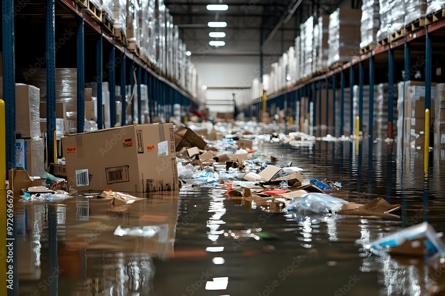Commercial water damage can devastate Omaha businesses, leading to costly repairs and operational disruptions. Understanding the common causes helps property owners implement preventive measures and recognize when to seek professional assistance.
How does weather cause commercial water damage?
Omaha's challenging climate creates unique risks for commercial properties. Heavy spring rains and rapid snow melts can overwhelm drainage systems, while winter freeze-thaw cycles stress plumbing and building materials. Local meteorological data shows our businesses face increasing risks from intense storms and flash flooding, particularly in areas like the Old Market and downtown where historic infrastructure may not meet modern standards.
1. Main Water Line Failures
Aging water infrastructure poses significant risks to Omaha's commercial districts. Many buildings still rely on original water mains installed decades ago, making them susceptible to sudden breaks and leaks. These failures often occur without warning, flooding lower levels and causing extensive structural damage.
Recent examples include burst mains affecting multiple businesses in the Old Market and along Dodge Street, where aging pipes couldn't withstand pressure fluctuations during extreme temperature changes.
2. Roof Leaks and Storm Damage
Omaha's severe storms frequently compromise commercial roofs through hail damage, high winds, and heavy rainfall. Flat roofs, common in commercial buildings, are particularly vulnerable to pooling water and membrane failures. Regular professional inspection becomes crucial during our intense storm seasons.
Local businesses often discover roof damage after severe weather events like the hailstorms that struck Millard and West Omaha, causing millions in commercial property damage.
3. HVAC System Malfunctions
Commercial HVAC systems can create significant water damage through condensation issues, blocked drain lines, and equipment failures. Our humidity swings make proper maintenance essential for preventing both chronic moisture problems and sudden flooding events.
Many Omaha office buildings have experienced flooding from frozen condensate lines during winter months or overflow events during peak cooling season.
4. Sprinkler System Issues
While essential for fire protection, sprinkler systems can cause extensive water damage when they malfunction. Freezing pipes, accidental activation, and deteriorating components all pose risks to commercial properties.
Local examples include recent incidents in downtown office buildings where sprinkler system failures affected multiple floors, demonstrating the importance of regular professional maintenance.
5. Plumbing System Failures
Commercial plumbing faces intense daily demands, particularly in restaurants, hotels, and office buildings. Common issues include burst pipes, failed water heaters, and backed-up drains that can quickly flood large areas.
Recent cases in the Aksarben area highlight how plumbing failures in upper floors can damage multiple levels of commercial buildings within minutes.
6. Foundation and Structural Problems
Omaha's expanding clay soils can compromise building foundations, leading to water infiltration. Cracks, settling, and deteriorating waterproofing materials create entry points for groundwater, especially during heavy rains.
Buildings near the Missouri River face additional challenges from soil instability and fluctuating water tables.
7. Drainage System Blockages
Clogged gutters, overwhelmed storm drains, and blocked interior drainage systems frequently cause water damage in commercial properties. Our seasonal debris and intense rainfall can quickly overcome poorly maintained systems.
Downtown businesses often experience flooding during sudden downpours when aging drainage infrastructure can't handle water volume.
8. Window and Door Seal Failures
Commercial windows and doors require proper sealing against Omaha's weather extremes. Failed weatherstripping, deteriorating caulk, and warped frames allow water infiltration during storms.
High-rise buildings face particular challenges from wind-driven rain penetrating through compromised seals.
9. Neighboring Property Issues
Water damage often originates from adjacent properties through shared walls, connected plumbing systems, or drainage problems. This commonly affects strip malls, office complexes, and mixed-use buildings throughout Omaha.
10. Equipment and Appliance Failures
Commercial kitchen equipment, water-cooled machinery, and office break room appliances can cause significant water damage through leaks or malfunctions. These incidents often occur during off-hours when no one is present to respond quickly.
Why choose professional water damage restoration?
When commercial water damage strikes, professional restoration services make the critical difference in protecting your business investment. Their rapid emergency response prevents secondary damage that often costs more than the initial water incident.
Professional teams use industrial-grade equipment and scientific drying methods to thoroughly remove water from all building materials, including hidden spaces. Their specialized tools detect moisture that standard cleanup might miss, preventing issues like structural damage and mold growth.
Most importantly, professional restoration teams provide detailed documentation throughout the process, from initial assessment through final restoration. This documentation proves invaluable for insurance claims and helps ensure proper coverage for all damage-related costs.
Why trust ServiceMaster of South Central Omaha?
ServiceMaster of South Central Omaha's commercial restoration team brings decades of local experience to every water damage emergency. Our certified technicians understand Omaha's unique challenges and provide rapid response to protect your business investment.
Contact us immediately when water damage threatens your commercial property. Our professional team stands ready 24/7 to minimize damage and restore your business operations.


